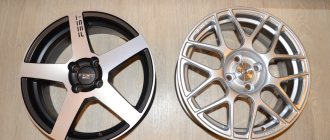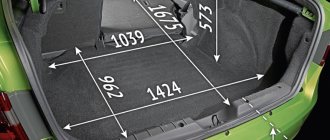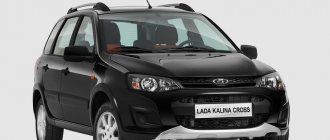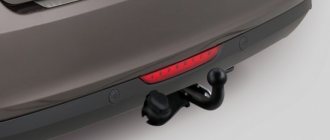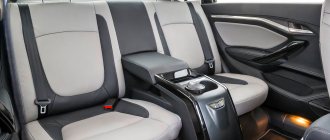Almost simultaneously, there were two more elevated passenger cars on the Russian market. AVTOVAZ launched the long-awaited Vesta SW Cross, and Kia responded with a special configuration of the Rio hatchback with the X-Line prefix. The starting price of a domestic car is 755,900 rubles; for a “Korean” they ask from 774,900 rubles. The cost makes it clear that these newcomers are direct competitors. Which one you prefer depends on what car parameters are important to you.
|
Kia Rio X-Line |
Adaptability to bad roads
On off-road terrain, the Lada Vesta SW Cross will give a Korean car a run for its money. According to the official specifications, the lowest point of its body is 203 mm from the ground, while the Kia's ground clearance is only 170 mm. This is even less than stated for regular Vests (178 mm), but by passenger standards the figure is not bad. Considering that Vesta’s wheelbase is only 35 mm longer than that of the Rio X-Line (2635 versus 2600 mm), from the point of view of geometric cross-country ability, Lada looks like a more correct option.
Vesta has ground clearance of 203 mm versus 170 mm for Rio. But the Kia is equipped with more practical high-profile tires.
Vesta has ground clearance of 203 mm versus 170 mm for Rio. But the Kia is equipped with more practical high-profile tires.
Lada Vesta Cross or X Ray: comparison of cars
First, let's evaluate the sales level of these models. Since Vesta in the “Cross” version was launched on sale quite recently, we will take sales of regular Vesta sedans and station wagons and compare them with the X-Ray indicators. There is the following data:
- a year after the start of production, the number of Lada Vesta station wagon cars sold reached 8,000;
- Lada is ahead of its competitors in terms of total sales of passenger cars;
- from January to August 2021, Vesta was the second most popular car after the Kia Rio, while the X-ray was only in 9th place. These are the total figures for the Vesta model, including the sedan and station wagon.
The statistics are already giving us pause. On the other hand, these data reflect not so much the quality of the cars sold, but the preferences of the car enthusiasts themselves and their purchasing power.
The average price for Vesta in the Cross version is about 788,900 rubles, while XRay will cost almost 100 thousand cheaper.
And if everything is clear with popularity, then from a price point of view the advantage is clearly not in favor of the Lada Vesta.
Comparison of dimensions and appearance
The cars are built on different chassis. In the case of X-Ray, this is the B0 platform, on which popular models of the Renault-Nissan concern are built. But Vesta has a completely original chassis design.
Body and dimensions
Externally, Lada Vesta and X-Ray are so similar that if it were not for the difference in height and body shape, one could confuse them even if they were placed next to each other. They have one thing in common: design at the level of modern foreign cars and the famous “X-DNA”.
This is interesting: Japanese SUVs Mitsubishi Pajero
Vesta Cross is a sedan, while the X-Ray is a hatchback. Vesta Cross is slightly lower and longer than the X-ray (4424 millimeters in length versus 4165 for the hatchback) and visually this gives it a more rapid appearance.
Dimensions of Lada Vesta Cross
Vesta Cross station wagon (Lada Vesta SW Cross) has the same dimensions as the sedan, with the exception of height - SW Cross has become 11 mm higher.
Dimensions of Lada Vesta SV Cross
Externally, Iksray gives the impression of a more “muscular” comrade - a small “jock” of the domestic automobile industry, taller and shorter than the elegant Vesta Cross.
Dimensions of Lada XRAY
Where the Vesta Cross modification definitely wins externally is in ground (203 millimeters versus 195 for its competitor). It's a small difference, but there are situations in which even a small advantage can be significant. Russian roads in a number of regions prove this truth every day. At the same time, do not forget that a loaded car loses 2-3 cm of ground clearance.
Lada X-Ray stands out from its competitor with a high window sill line, visually making the car somehow more powerful. “Compact high hatchback” is how it is officially called, and the Lada X-Ray fully justifies this name.
After just a couple of years of launching into the series, the Lada Xray has already completely fit into everyday reality, is selling well (see statistics at the beginning of the article) and has found constantly warring armies of fans and haters on the Internet.
The fact is that AvtoVAZ wanted to stuff a newly designed body into the base from Renault Sandero Stepway. The result was controversial.
The dimensions of the VAZ Xray are almost identical to the Sandero, including the length of the body and the size of the wheelbase. Even the head optics are very similar to those installed on the Stepan. But despite its continuity, the new Lada has become a market bestseller, although not as popular as Vesta.
The XRay body turned out to be truly original in appearance, although the Sandero is considered a more status model by the group. Partly because the basic version has only 15-inch wheels, and only higher trim levels can afford 16- or 17-inch ones.
Xray is the result of a compromise integration of a new body into a chassis that has long been mastered on the assembly line. Questions may arise here regarding the passive protection of passengers, since the car has not passed the EuroNCAP tests. But many were most disappointed by how the production hatchback looks compared to the concept.
This is the production car:
And this is the design prototype:
Agree that the car has lost most of its charm. All that remains is the notorious letter X in the front part and on the side stampings. But the result was at least a repairable design. Just ask yourself: could the manufacturing plant change assembly equipment and retrain staff in a short time? That's it...
Salon
In the interior of the Vesta Cross, the ergonomics of the front panel make a pleasant impression. A serious drawback is the inability to display speed information on the on-board computer display, since the analog instrument scales are difficult to read during the day.
But in general, the interior is put together so well that even the plastic trim does not make any squeaks. Noise insulation, as already noted by many reviewers, is better than in the XRay, and is already ahead of that of the concern's previous budget models. Even at a speed of about 130 km/h, you can carry on a conversation (although at such speeds it is better not to be distracted by chatter).
Vesta Cross salon:
Now let's take a look at the ergonomics and equipment of the Lada XRay. Like the exterior, the interior environment doesn't look as great as the 2012 prototype. Compared to Vesta Cross here:
- no central armrest,
- many control buttons are inconvenient (heating, for example) and you still need to reach them,
- the required antifreeze temperature indicator is missing on the dashboard of the XRay hatchback,
- unsatisfactory visibility through the central rearview mirror and generally from behind, since the window behind is too small.
The common problem of both cars is that the multimedia system is not very fast and the navigation is not the most advanced.
Three adult passengers can fit relatively comfortably behind the driver. “Relatively” - because the ergonomics of the rear seats are not conducive to long trips. And even in the maximum configuration, there is no longitudinal adjustment of the sofa and is not expected.
And how did it happen that the trunk of the XRAY is smaller than that of the Vesta?
Overall: alas, Xray loses to Vesta in terms of visibility and interior ergonomics. Although it’s worth mentioning about Vesta’s armrest that it interferes with using the handbrake. It would be better if it were movable.
Ride and Handling
The Vesta Cross sedan has the same chassis as the previous SW Cross station wagon and, apart from the body type, there are no significant differences. Their main units are identical, even many body parts are compatible. There is a difference in the suspension design (springs, shock absorbers), and in the bifurcated muffler and plastic body kit, which cannot be installed on a regular Vesta sedan.
The difference in price between just a Lada Vesta and Vesta with the Cross prefix, depending on the version, is 53 – 63 thousand rubles. If you choose between a “cross” sedan and a station wagon, then the cost of the latter will be 32 thousand more expensive - this is a standard surcharge for the two-volume body of the Vesta.
Transmission Lada Vesta and X-Ray
Neither Vesta Cross nor XRAY differ from each other in their set of engines and gearboxes. But the hatchback has more trim levels and the price for the initial version is 579,900 rubles versus 763,900 for Vesta. However, the sedan has better handling and acceleration dynamics. But there are controversial points : Vesta Cross drives normally on the highway, but in traffic jams there is a noticeable lack of traction at the “lower levels”.
The top version of XRAY has a trump card hidden up its sleeve - “robot”! It is he who helps where it is difficult to travel. However, sometimes it is inadequate in choosing driving modes, so most owners prefer “mechanics”: nerves are more expensive.
The transmission of the Vesta Cross sedan is slightly different from that found on station wagons. According to the manufacturer, the robotic gearbox of the top-end Vesta now changes gears faster. True, journalists who could tell about the updated “robot” AMT 2.0 never got it. In this regard, you’ll have to take the marketers’ word for it... But no one has any complaints about the “mechanics”. probably a draw in this round between Cross and XRAY.
Available engines and fuel consumption
For both cars, engines with a displacement of 1.6 and 1.8 liters, with a power of 106 and 122 hp, of domestic production are available. It is worth mentioning separately the Japanese motor for the XRAY, which is currently no longer installed on it , since it is more expensive and more difficult to maintain. As for the VAZ 1.8-liter engine under the symbol VAZ-21179, it is, in fact, experimental and there are complaints about it. There is an opinion that its 122 “horses” are not enough for country roads, so overtaking must be done with careful calculation, as if you were a racer. The tachometer cutoff occurs earlier than expected.
However, within the city the dynamics of the 1.8-liter unit are sufficient. But real fuel consumption is controversial: it never drops below 8 liters per “hundred” . But here Vesta and XRAY maintain parity: the engines are the same! Moreover, Vesta is definitely capable of driving 700 km on a full tank without refueling, but under conditions: on good roads and with high-quality gasoline. Speaking of fuel, there are differences: Vesta needs 92 gasoline, while XRAY uses AI-95. Taking into account current fuel prices, this can play a decisive role in the choice between the cars under review. But there is a mitigating point here - after upgrading the VAZ-21129 engine, the use of AI-92 is also allowed.
There is no point in even comparing them in terms of speed: both cars are designed for relatively quiet driving. These are not sports sedans, but rather cars for travelers (with a stretch) and for family people (the latter applies more to the XRAY).
Suspension and handling
The Vesta Cross sedan's ride turned out to be worse than that of conventional sedans - the stiffer suspension and 17-inch wheels with low-profile tires (205/50 R17) are to blame.
But the car turns confidently and without rolls. And no road bumps can throw Vesta off course (which cannot be said about the oncoming air currents from oncoming trucks on country highways).
In terms of handling, Vesta is more playful than Xray, which especially helps on unpaved sections of the road and off-road. The steering wheel responds to even the slightest movement.
Capacity
The Lada Vesta SW Cross is larger than the Korean car: 4424 mm in length and 1785 mm in width versus 4240 and 1750 mm, respectively. And Vesta’s wheelbase is a little longer, as we have already found out. That’s why the Lada passengers will have a little more space.
As for the luggage compartment, it is obvious that the station wagon has more room than the hatchback of the same class. We haven’t had time to measure the Rio X-Line’s trunk volume yet, so we’ll rely on factory data. The manufacturer promises 390 hp. Vesta claims much more - 480 hp. Both indicators are given based on loading “under the curtain”. In the Lada, the volume of the cargo compartment is limited by the littered rear pillars, but it still surpasses the Kia in terms of maximum capacity. So if you plan to frequently load your car to capacity, Vesta SW Cross is your choice.
The domestic model loses in terms of the maximum level of safety: it has only four airbags. But they are already provided in the “base”, while Kia will have only two pillows, if you are not ready to pay at least 965 thousand rubles for one of the top versions.
The domestic model loses in terms of the maximum level of safety: it has only four airbags. But they are already provided in the “base”, while Kia will have only two pillows, if you are not ready to pay at least 965 thousand rubles for one of the top versions.
Comparison of kia rio x-line and lada vesta sw cross
It seems that the Koreans have decided that you can’t get enough “neVest” for every Vesta. Instead of quickly “lifting” and covering the elderly Cee’d SW station wagon with unpainted plastic, they rolled out the new KIA Rio X-Line hatch in a cross-format. We compared it with the editorial Lada Vesta SW Cross (at the time of the test we did not have time to buy our own X-Line). The result was as expected, but the opponents were able to surprise us with something. It's a pity that not all surprises were pleasant.
Good! Lada Vesta SW Cross is perhaps the first truly beautiful station wagon in the post-Soviet history of the domestic automobile industry. A wide edging made of unpainted plastic noticeably improves the proportions, and even the obtrusive “X’s” on the sides hardly spoil the silhouette. But the KIA Rio X-Line also looks good in profile, and at the back the “Korean” is even better than the Lada - the trunk door is neatly crossed in half with a straight line of brake lights, a modest emblem, even stamping under the license plate. From the trunk door of the Vesta SW Cross, standing next to it, you just want to rip off the dimensionless letters - a small boat in an oval would be much more appropriate here. But the “dynamic shield”, excuse me, “X-Face”, worked out better for Steve Mattin than his Japanese colleague from Mitsu, who was too keen on cartoons about samurai. From the front, Vesta is moderately aggressive, rather cheerful, especially against the backdrop of the sad, slightly flattened “face” of the KIA Rio X-Line.
The “Korean woman’s” sadness is easy to understand - the “long-legged” Russian beauty with an “official” ground clearance of 203 mm parks above any curb as a joke. The owner of the KIA Rio X-Line will have to be careful - the ground clearance is only 170 mm. Even the regular Lada Vesta SW has 8 mm higher ground clearance.
KIA Rio X-Line (length 4240 mm) is 184 mm shorter than the Lada Vesta SW Cross (length 4424 mm), but the ground clearance of the “Korean” is only 170 mm. This is less than the regular Vesta SW (178 mm). Vesta SW Cross with a ground clearance of 203 mm compared to the KIA Rio X-Line is a real “SUV”, and even a budget one - 847,900 rubles in the maximum configuration. Moreover, the equipment is equipped with options no worse than that of the top-end Rio X-Line for 1,024,900 rubles
The beautiful “packaging” of the Lada Vesta SW Cross gives rise to hope that everything will be fine inside. At first glance, this is true. But when you start to look closely at the details, numerous “jambs” begin to peek out from under the thick layer of orange “plaster.” The steering wheel is hard, the power window buttons almost scratch your fingers, you need to press them with great effort. The speedometer scale is hard to read due to the large, almost continuous digitization, and the riot of colors dazzles the eyes. To use the handbrake lever (and with the “robot” you have to pull it constantly), you need to twist your hand around the center armrest cover, which protrudes strongly forward. But the steering wheel is good - it is adjustable not only for the angle of inclination, but also for the reach, the platform for the left foot is deep, even a tall driver can sit. Chair back with lumbar support. But its successful profile is only half the battle: the bottom cushion is short, the seat itself is a bit hard compared to the KIA. But on the second row of Vesta there is almost royal space. The gap between the knees and the back of the chair, if you sit behind yourself, is noticeably larger. True, the sloping ceiling, as in the X-Line, turns out to be almost directly above the head of a tall passenger.
The interior of the Lada Vesta SW Cross is much more interesting and comfortable than its alliance brethren - Renault Sandero Stepway, Duster and Kaptur. The chair does not hurt your back, the steering wheel is adjustable not only for the angle of inclination, but also for the reach! However, Vesta is still inferior to the KIA Rio X-Line in ergonomics
The speedometer is almost unreadable, the armrest cover covers the handbrake lever. The front seat has a good profile and lumbar support, but the bottom cushion is short. The rear is more spacious than in the X-Line, and the trunk is simply a miracle, although not too large: from 480 to 825 liters
But the best part of our wagon is the trunk. And not only because 90 liters in the minimum volume wins. Even the Swedes will envy the organization of space in the cargo compartment! Above the spare tire niche are two huge foam containers with durable lids. Thanks to this add-on, the floor during cargo transformation is flat and the threshold is low. On the left side there is an open box, the curtain is tight, does not sag, moves along the grooves and is fixed securely. The KIA Rio X-Line has a solid shelf instead of a curtain, but there is no such “warehouse superstructure” here. Therefore, behind the threshold of the trunk, compared to the Vesta, there is a hole, and the folded rear seats form a tall step. And closing the fifth door in the KIA is not so convenient - it has only one small handle, while the Vesta has two wide “handrails”.
Finishing materials in KIA are better both in appearance and to the touch, ergonomics are at a height unattainable for AvtoVAZ
“Tidy” does not make an impression, but it is perfectly readable. The climate control unit is more convenient and looks more expensive. The driver's seat is more comfortable without lumbar support, and also not as hard as in Vesta. The rear is not cramped, but there is no room to spare. The trunk does not show the miracles of transformation; the threshold is high; with the seats folded down, a large step is formed. The volume of the cargo compartment is from 390 to 1075 liters according to official data. At maximum it is 250 liters more than the Lada Vesta SW Cross
It’s a pity, you won’t live by the trunk alone, and in terms of interior quality, the Vesta SW Cross is inferior, and the flashy orange inserts in the trim cannot hide the ergonomic flaws. After the “cheerful” Vesta, the Rio X-Line at first seems a bit gloomy. But, having turned the handles of the climate control unit, pressed the buttons, touched the grippy steering wheel and looked at the simple, but perfectly readable “tidy”, somehow I don’t feel drawn to return to the steering wheel of the Russian station wagon - it’s noticeably more comfortable behind the wheel of a KIA.
The optional equipment is almost par with Vesta: single-zone climate control, budget media system, video camera with trajectory prompts on the screen, step-by-step heated front seats. But Vesta doesn’t have a heated steering wheel, and it’s easier to manage all this stuff in Rio—the Koreans didn’t spare any “physical” buttons. The central tunnel is arranged much more successfully: the deep cup holders are not blocked by the gearbox selector, there is a larger capacity under the dashboard, and above it there are not one, but two 12V sockets. But the Rio’s glove compartment is a bit small—you can’t fit A4 folders in there, like in Vesta.
Our Lada Vesta SW Cross is equipped with a 1.8-liter engine producing 122 hp. and an AMT robotic transmission, which is a regular VAZ 5-speed manual transmission with ZF electric actuators responsible for pressing the clutch and changing gears
However, comfort is a relative concept. And there are not too many complaints about Vesta in this regard - just little things that can be easily overcome. But it is absolutely impossible to get along with the AMT “robot”. Don't be fooled by the cheap opportunity to get rid of the third pedal, especially if you're new to driving. VAZ's 5-speed manual transmission with ZF actuators attached to it is a constant source of emergency situations. An eternity passes between pressing the gas pedal and starting to move; gears are switched only after the engine “hangs” in a long pause, resting against the rev limiter. During any maneuver - be it entering a busy intersection or even basic overtaking - you need to make a huge allowance for the catastrophic “stupidity” of the robotic transmission. At one time, I drove a lot in the Renault Sandero Stepway with a “robot” - it’s also not great, but there the delay and the moment of switching could at least be predicted. Vesta is completely unpredictable. There are only two ways out of this situation: either “slow down” yourself, forever forgetting about dynamic driving, or switch to manual mode. The latter, however, is also not a panacea, and why then overpay for an automatic transmission?
To unlock the potential of the 122-horsepower 1.8-liter engine, VAZ needs to properly “finish” the algorithm. Koreans don’t need to finish anything.
The 1.6-liter 123-horsepower engine and the 6-speed automatic transmission of the KIA Rio X-Line are a great pair, but it’s better not to buy a Lada Vesta SW Cross with a robot
The combination of a traditional 6-speed torque converter automatic transmission and a 1.6-liter engine producing 123 hp. perfect. KIA Rio X-Line does not like surprises and, to the best of its ability, which, despite its more modest volume, is no less than that of Vesta, does everything to make the driver feel calm and confident. I never even wanted to switch to manual mode. The transmission is already efficient, there are enough dynamics, the Korean hatchback accelerates to “hundreds” in 11.6 seconds. This is only 1.7 seconds faster than Vesta, but thanks to the well-coordinated work of the engine and gearbox, this small difference is very noticeable. And in general, Vesta’s 1.8-liter engine is also not the most profitable purchase. Proven 1.6-liter engine with 106 hp. more reliable, and even more dynamic on the “handle”: it accelerates the “mechanical” Vesta SW Cross to “hundreds” in 12.6 seconds (0.7 seconds faster than the “robotic” one).
This is interesting: The largest truck in the world is huge and powerful trucks
Broken primers are the native element of the “cross” Vesta: the interior does not rattle, the suspension cannot be pierced. So it’s better to increase the speed - at low speeds the Russian station wagon will “beat”
The “Korean” steers well; at parking speeds the steering wheel is light, but in fast turns it becomes slightly heavier. The Rio stays on course clearly; you can’t throw it to the side on the asphalt track. Vesta’s steering wheel is always “clamped”: apparently, the developers wanted to get a clear “zero”, but what came out was a thick, viscous “porridge”. The suspension of the domestic station wagon also raises questions. The directional stability is good, there is almost no lateral roll, Vesta tries not to bother with information about small irregularities, there is almost no sway on waves, but the SW Cross reacts to speed bumps and potholes “in the opposite way” - the lower the speed, the more it shakes. The Rio X-Line was a pleasant surprise: compared to the regular Rio, it responds noticeably more softly to small things, and you can feel the increased energy reserve. Driving around the city driving an X-Line is generally more comfortable than driving a Vesta. I was already beginning to think that the Koreans had finally learned how to make suspension for any Russian roads, when a sharp “kick” from the “lounger” brought me back to earth - the engineers from the Land of Morning Freshness still have something to work on.
The KIA Rio X-Line is good on the highway, although the noise insulation needs work - the Vesta is a little quieter on grainy asphalt. Having driven onto the ground, the “Korean” immediately loses ground: the shock absorbers cannot cope with large irregularities, the swing is too great, but at low speeds the X-Line is more comfortable
I had to finally give up my high expectations on broken concrete. Here the KIA Rio X-Line completely “withered” - a hail of unpleasant impacts, felt not only by the “fifth point”, but also on the steering wheel, fell after 40 km/h. “Vesta” went far ahead, but did not open up right away. “I was carrying firewood” until I increased to 50 km/h. It was here that the elastic elements finally worked as expected and crossing the road of slabs with joints began to be a pleasure. The suspension of the Lada Vesta SW Cross is very energy-intensive, almost impenetrable, but too “oaky”.
To make it soft everywhere and always, Vesta must either be driven or loaded. The KIA Rio X-Line, on the contrary, requires leisurely and careful driving on broken roads, especially on wavy dirt roads: it doesn’t seem to reach the point of breakdown, but due to the low ground clearance on the waves you are afraid to hit the crankcase - the sway is too great.
The dynamic stabilization systems of rivals are turned off and allow slipping, while the Vesta SW Cross’s “anti-slip” system also does a good job of simulating self-locking. Everything would be fine, but already “at half throttle” under the bottom, it’s as if they’re starting to hit an empty tin bucket with a shovel. It’s strange, because Vesta doesn’t seem to suffer from a traction deficit
Off-roading is a completely optional discipline for the KIA Rio X-Line. There is not enough ground clearance, the front overhang is long, and the wheelbase is only 35 mm shorter than Vesta. The X-Line can handle neither deep ruts nor changes in terrain. True, the SW Cross cannot cope with serious kinks in the terrain, but it has less chance of sitting on its belly in the spring thaw. As a last resort, both rivals have stationary towing brackets at the rear, and Vesta’s rear eye is located high, and there is even a special recess in the bumper for it. In the X-Line it is lower and deeper in the overhang; it is better to attach the cable to it in advance. Dynamic stabilization systems of competitors can be turned off using buttons; there is no need to go into the menu.
Having placed the KIA diagonally in a small ditch, I had no hope of getting out of it on my own, but the “Korean” only needed two or three attempts. A little slip and the X-Line is free again. Vesta, despite much less grippy tires, coped better. Its traction control system is capable of simulating inter-wheel locking quite well, and if the SW Cross is equipped with a real “self-locking” system, it will become even more fun. This modification is inexpensive - fifteen thousand including installation. If you save 25,000 rubles by abandoning the harmful off-road “robot,” then there will still be money left over.
The Lada Vesta SW Cross is sold only in good trim levels, so you can safely take the cheapest 1.6 Luxe 5MT for 755,900 rubles - the list of options here is actually the same as that of the top version. You will only have to sacrifice enhanced tinting of the rear windows, a multimedia system with a 7-inch screen, a rear view camera and built-in navigation. The sacrifice is small, the basic Vesta SW Cross is equipped with an audio system with a 4.3" monochrome display, equipped with Bluetooth, Hands free and an SD card slot. But until AvtoVAZ has a high-quality automatic transmission or at least a CVT, it’s better to forget about two-pedal Vestas. To pay from 805,900 to 847,900 rubles for a car with such a transmission - no, thank you! Having only a hundred thousand rubles more on hand, you can ask the price of an all-wheel drive crossover with an automatic transmission, even if it is a Renault Duster in the poor Expression configuration, where you even have to pay extra for ESP. Well, the KIA Rio X-Line in the Premium “top” costs like a cast-iron bridge - 1,024,900 rubles! We tested the Prestige AV version. It is a little cheaper - 964,900 rubles - but without built-in navigation and with fabric seats. The minimum price for a 1.6-liter Rio X-Line with an automatic transmission is 839,900 rubles. The equipment is worse than the initial Vesta SW Cross: no climate control, no Bluetooth, no parking sensors, rear drum brakes. In essence, this is the same “base” as in the “entry” 100-horsepower Rio X-Line 1.4 MT for 774,900 rubles. So if you need a well-equipped station wagon with very high ground clearance and powerful suspension, then the Lada Vesta SW Cross wins by a landslide. True, still with numerous reservations.
Technical characteristics of the tested vehicles (manufacturers' data)
Lada Vesta SW Cross 1.8 AMTKIA Rio X-Line 1.6 ATBodyEngineTransmissionBrakesSuspensionDimensions, volume, weightDynamic characteristicsFuel consumption, l/100 kmCar cost, rub.
| Type | Station wagon | Hatchback |
| Number of seats/doors | 5/5 | 5/5 |
| Type | Petrol | Petrol |
| Engine location | Front transverse | Front transverse |
| Number and arrangement of cylinders | 4, in a row | 4, in a row |
| Working volume, cubic meters cm | 1774 | 1591 |
| Power, hp at rpm | 122/5900 | 123/6300 |
| Torque, Nm at rpm | 170/3700 | 151/4850 |
| Drive unit | Front | Front |
| Transmission | 5–RCP | 6–automatic transmission |
| Front | Ventilated disc | Ventilated disc |
| Rear | Disk | Disk |
| Front | Independent, spring, McPherson | Independent, spring, McPherson |
| Rear | Semi-dependent, spring | Semi-dependent, spring |
| Length/width/height, mm | 4424x1785x1532 | 4240x1750x1510 |
| Wheelbase, mm | 2635 | 2600 |
| Ground clearance, mm | 203 | 170 |
| Curb/gross weight, kg | 1350/1730 | 1203/1590 |
| Fuel tank volume, l | 55 | 50 |
| Trunk volume, l | 480–825 | 390–1075 |
| Tires | 205/50R17 | 185/60R15 |
| Maximum speed, km/h | 181 | 183 |
| Acceleration to 100 km/h, sec. | 13,3 | 11,6 |
| Combined cycle | 7,7 | 6,8 |
| CO2 emissions, g/km, eq. Class | n. d., Euro-5 | n. d., Euro-5 |
| Basic equipment | 805 900 | 839 900 |
| Test package | 829 900 | 964 900 |
Equipped with security systems
Lada Vesta SW Cross (Luxe Multimedia)KIA Rio X-Line (Prestige AV)
| Front airbags (driver/passenger) | +/+ | +/+ |
| Side airbags | + | + |
| Curtain airbags | – | – |
| Driver/passenger knee airbag | –/– | –/– |
| Inflatable seat belts for rear passengers | – | – |
| ESP stabilization system | + | + |
| Traction control system TCS | + | + |
| Anti-lock braking system ABS | + | + |
| Brake Assist | + | + |
| Rear View Camera | + | + |
| Front/rear parking sensors | –/+ | –/+ |
| Parking assistance system | – | – |
| LED headlights | – | – |
| Xenon headlights | – | – |
| Adaptive headlights | – | – |
| Fog lights | + | + |
| Availability of two/three rear head restraints | –/+ | –/+ |
| Isofix fastenings | + | + |
| Tire pressure monitoring system | – | + |
| Lane Change Assistance System | – | – |
| Marking tracking system | – | – |
| Forward Collision Avoidance System | – | – |
| Traffic Sign Recognition System | – | – |
| Driver fatigue monitoring system | – | – |
| Turning on the hazard warning lights during emergency braking | + | + |
This is interesting: For centuries: choosing an unbreakable SUV up to 1,000,000 rubles
Appearance
It will certainly not be possible to identify a winner here. Both models are different, but very beautiful. Therefore, everyone must decide for themselves what to choose – KIA Rio X Line or Lada Vesta SV Cross.
The KIA impresses with its flowing optics that climb almost into the middle of the hood, and an aggressive bumper with a silver trim at the bottom and a large air intake. While the narrow radiator grille harmoniously complements the picture.
Unlike Vesta, Rio does not have expressive stampings on the sides - here the designers chose a calmer style, smoothing out the panels on the doors and wings. But in the rear there are some sporty notes - a forked muffler, long stops with a narrow bridge on the fifth door, a wing above the glass and a lining at the bottom of the rear bumper.
And, of course, a cross-body kit. The plastic that surrounds the bottom of the Rio X Line looks great, and also protects the car’s paintwork from damage.
AvtoVAZ designers have a slightly different approach. It is noticeable that they relied on aggressiveness, and although this decision has opponents, the image of the car turned out to be quite successful.
From the front you can see the familiar letter “X”, made up of a pair of chrome moldings, as well as a radiator grille and air intake, fused into one. The optics, compared to its Korean counterpart, are made in a more familiar form.
On the side are the same X's as in the front. It’s all an acquired taste – some people like this design solution, some don’t. But the fact that the car stands out in the crowd is an indisputable fact. Separately, it is worth noting the impressive 17-inch wheels.
The rear is also nothing new - angular lights, huge LADA letters on the fifth door, a wing, a trim at the bottom of the bumper, etc. A cross body kit is also present, approximately the same as that of the competitor.
Capacity
The Lada Vesta SW Cross is larger than the Korean car: 4424 mm in length and 1785 mm in width versus 4240 and 1750 mm, respectively. And Vesta’s wheelbase is a little longer, as we have already found out. That’s why the Lada passengers will have a little more space.
As for the luggage compartment, it is obvious that the station wagon has more room than the hatchback of the same class. We haven’t had time to measure the Rio X-Line’s trunk volume yet, so we’ll rely on factory data. The manufacturer promises 390 hp. Vesta claims much more - 480 hp. Both indicators are given based on loading “under the curtain”. In the Lada, the volume of the cargo compartment is limited by the littered rear pillars, but it still surpasses the Kia in terms of maximum capacity. So if you plan to frequently load your car to capacity, Vesta SW Cross is your choice.
Interior
If we do not consider the issue of configurations, and simply evaluate the interior of both cars, then we can admit that the KIA Rio X Line is better than the Lada Vesta SV Cross, although there is still no overwhelming advantage.
KIA pleases with the quality of its work. The plastic is inexpensive, but you can’t fault the build quality, and its texture is very pleasant. The ergonomics are well thought out, especially the dashboard, which looks good and is easy to read, and the keys are pleasant to the touch. The interface of the multimedia system is simple and clear.
We are pleased with the well-organized central tunnel with a pair of cup holders, a place for a smartphone and a spacious niche right next to the center console.
The seats are soft, although there is no lumbar support. The rear sofa is very cozy, but a little small, and therefore you will have to make room a little in the gallery. The trunk in its normal position is so-so, but with the rear seat folded down it will give Vesta a head start. Visibility is also disappointing, although the A-pillars are not too wide.
As for the interior of the Lada Vesta SV Cross, it outperforms its competitor in some respects. In particular, there is lumbar support in the seats, the mirrors are noticeably larger, and the seating geometry is comfortable. The second row is significantly more spacious than in the X-Line, and the trunk is larger, although when unfolded it is still inferior to its counterpart.
But there are also shortcomings. This concerns, first of all, the quality of materials and workmanship. Of course, SV Cross is a big step forward, but it still falls short of KIA. There are some annoying miscalculations in ergonomics - it’s inconvenient to fasten seat belts due to the fact that the lock is too recessed, the front seat headrests protrude too far forward, and controlling the on-board computer and multimedia is also not the easiest.
The glove box lid is equipped with a microlift, but it works so-so, the steering column switches are clumsy. Well, the power window unit, borrowed from Granta, looks completely miserable.
Comparing the interior of the Lada Vesta SW Cross with the Kia Rio X-Line, you pay tribute to the big step forward on the part of the designers of the domestic car.
Lada-Vesta-SW-Cross: Simple but comfortable seats with lateral support, beautiful, even stylish dashboard design. But you can recognize the smell of domestic plastic when you open the door slightly.
Against the backdrop of a decent implementation of complex technical solutions (an excellently debugged navigation system), there are offensive punctures in small things - the radio is annoying with a multi-second delay when turned on, power windows with sloppy frames risk unpleasantly damaging your fingers, and the original markings and illumination of the speedometer scale are not convenient for all drivers.
In the Kia Rio X-line, simple lines and even inexpensive materials look great. The central screen is facing the driver and is easy to read even in sunny weather, which cannot be said about Vesta’s screen.
A leather-wrapped steering wheel with the correct diameter, strict inserts, more comfortable seats - all this adds up to make you feel that the car is more expensive than it actually is. Of course, this is true primarily for the top versions of the Rio X-line, but even they do not have a frightening price.
In contrast to the bright design of the Vesta SW, the Rio's interior is conservative and restrained. However, there are no complaints about the quality of materials and workmanship; we are pleased with the pleasant little things that are not available in Vesta SW at any price.
Engine and gearbox
The Koreans did not highlight the interior of the pseudo-crossover with any decor. The most expensive configuration includes eco-leather trim. A dubious advantage, given the quality of this material.
The Koreans did not highlight the interior of the pseudo-crossover with any decor. The most expensive configuration includes eco-leather trim. A dubious advantage, given the quality of this material.
Vesta flaunts dynamic markings in the image from the rear view camera. Rio responds with two options for the multimedia system. One has its own navigation, the other can only broadcast it from the screen of the owner’s smartphone.
Vesta flaunts dynamic markings in the image from the rear view camera. Rio responds with two options for the multimedia system. One has its own navigation, the other can only broadcast it from the screen of the owner’s smartphone.
All versions of the Kia Rio X-Line have a warm steering wheel. Perhaps in the future this option will appear in Lada.
All versions of the Kia Rio X-Line have a warm steering wheel. Perhaps in the future this option will appear in Lada.
Kia offers a choice of two petrol engines for its lifted hatchback, with a power of 100 and 123 hp. The Lada engine line includes comparable units of 106 and 122 hp. So there is parity in power. As well as in terms of acceleration dynamics. The “Korean” covers the first 100 km/h in 10.7–13.4 seconds, depending on the power unit. Lada - in 11.2–13.3 seconds. Both cars allow the use of AI-92 gasoline, but Kia is more economical. Fuel consumption for the Rio X-Line in the combined cycle varies from 5.9 to 6.8 l/100 km, while for the Lada it ranges from 7.5 to 7.9 l/100 km. Of course, real figures will differ from those stated, but official measurements were carried out using a single methodology, so we have the right to compare them.
The Koreans offer a modern 6-speed automatic transmission as an option, for both engines. The domestic car has only a robot with one clutch, which only the laziest would not kick for slowness. Moreover, it is available exclusively in combination with a 122-horsepower engine. So for fans of a comfortable and at the same time dynamic ride, Lada can only offer a manual version.
|
A rear folding armrest with a pair of cup holders is an attribute of Vesta with the Prestige package. Kia doesn't have that. |
Heated rear seats have become the norm for B-class budget employees. Both cars are equipped with it in the two most expensive trim levels. | |
Prices and options
- Cost of KIA Rio X-Line from 774,900 rubles. (1.4 6MT) up to 1,024,900 rub. (1.6 AT).
- Cost of Lada Vesta SW Cross from 755,900 rubles. (1.6 5MT) up to 847,900 rub. (1.8 5AMT).
- Lada Xray costs from 599,900 rubles. (1.6 5MT) up to 830,900 rub. (1.8 5AMT).
Car configurations that are available at approximately the same price:
| Model | KIA Rio X-Line | Lada Vesta SW Cross | Lada Xray |
| Equipment | Comfort 1.4 6MT | Luxe Multimedia 1.6 5MT | Luxe Prestige 1.8 5MT |
| Price | RUB 774,900 | RUB 779,900 | RUB 773,900 |
| Side airbags | No | Yes | No |
| Heated steering wheel | Yes | No | No |
| Electrically heated windshield | No | Yes | Yes |
| Discs | 185/65R15 | 205/50 R17 | 205/50 R17 |
| Front fog lights | No | Yes | Yes |
| Climate control | No, air conditioning | Yes | Yes |
| Cooled glove box | No | Yes | Yes |
| Audio system | without touch screen | Multimedia system with navigation 7" | |
| Cruise control and speed limiter | No | Yes | Yes |
| Rear View Camera | No | Yes | Yes |
| Rear parking sensors | No | Yes | Yes |
| Light sensor and rain sensor | No | Yes | Yes |
| Rear disc brakes | No | Yes | No |
KIA Rio X-Line receives the missing options only in more expensive trim levels, for example:
- Front fog lights and climate control in the version for 824,900 rubles.
- Electrically heated windshield, rear disc brakes, multimedia system with 7" display, rear view camera and parking sensors and light sensor in the version for 964,900 rubles.
- Wheels 195/55R16 in the version for 1,024,900 rubles.
- And there is no cruise control, speed limiter or rain sensor at all.
In the TOP trim levels (price is under a million), the KIA Rio X-Line boasts options that are not available on the LADA, for example:
- Projection type headlights (lensed);
- Heated windshield washer nozzles;
- LED tail lights;
- Keyless entry system;
- Supports Android Auto and Apple Car Play.
Eventually
, for the same money you can buy a KIA Rio X-Line in the basic version, or a Lada Vesta or XRAY in the “luxury” configuration. Yes, in such a situation, a foreign car is significantly inferior to LADA models in terms of equipment, but for an additional fee you can get it with an automatic transmission, which AVTOVAZ cannot yet offer. A similar situation can be seen when comparing the Lada Vesta and the new Hyundai Solaris.
Have you compared these models? What car would you buy with 780 thousand rubles in your pocket?
Keywords: Lada Vesta Cross
+9
Share on social networks:
Found an error? Select it and press Ctrl+Enter..
In the back seat
In terms of wheelbase length, even despite the increase of 3 cm that occurred during the generation change, the Rio X-line is still inferior to the Vesta SV cross and this is especially felt from the rear. In terms of the width of the sofa, the competitors are close, but in terms of legroom, Vesta doesn’t have much, but it wins. Thanks to the two-volume body, the roof does not lie on your heads, and in expensive versions, both cars boast a heated rear sofa.
But in the rear, the Vesta SW shows both the advantages of a larger wheelbase and concern for passengers - there is more room for the legs than in a Korean car, there is both a USB connector and a 12V socket.
The Rio X-Line's interior is a little narrower and cramped at the back than in Vesta; the lack of dimensions cannot be hidden by a competent layout.
For rear passengers, a domestic car is more preferable - points in favor of Lada.
Score 3:4 - X-line leads.
Vesta SV Cross - Kia Rio X-line test at a traffic light.
It is always interesting to compare the acceleration dynamics of cars of the same power - the 0.2 liter advantage of the domestic VAZ-21179 engine over the Korean one is expressed in 19 Nm of torque, in addition, during fast acceleration, the Lada manual transmission seems preferable to the Kia “automatic”. The Korean hatchback has its own trump cards: the Rio X-Line is almost 20 centimeters shorter than the station wagon and 150 kilograms lighter.
With equal power, the dynamics of the cars should be very similar. The Vesta SV Cross has a larger torque reserve of 170 Nm versus 151 for the Kia Rio X-line and more efficient mechanics. The X-line relies on slightly less weight and a 6-speed automatic with shorter gears.
The Lada 1.8 with manual accelerates to hundreds in 11.2 seconds, while the Rio 1.6 AT is four tenths slower. However, several parallel starts gave completely the opposite result. Kia Rio X-line is consistently faster. Perhaps our Vesta SV Cross was unlucky with the engine settings, but no matter how we tried to start, changed cars and called up different ESP modes, in most attempts the Lada remained behind.
For an optimal start, you need to clearly keep the engine speed around the 3000 mark, turn off the stabilization system in advance and switch in time. In the first gear, the cutoff is triggered even before 6000 rpm, while in the second and subsequent gears it is about 6500 rpm. The Kia Rio X-Line accelerates more stable, in each gear the engine revs to 6500.
The Rio X-Line automatic transmission will not please you with its racing character when starting with two pedals, but this is not required from a family car - predictable behavior and trouble-free operation are more important. However, the Rio X-Line did not leave a chance for the Vesta SW Cross in the head-to-head competition: both times, on the short straight of our training ground, the Korean hatchback “brought” more body weight to the domestic station wagon.
The score is 0:1 in favor of X-line.
A short, slow track with a dry, dusty surface will judge the competitors in the handling test.
The specifics of the improvised track revealed a peculiarity in the electronics settings on the Vesta SW Cross: at the slightest suspicion of an emergency situation, the Lada strangles the engine, preventing it from entering a skid. The conservative chassis is a plus for the consumer, but not the best assistant when driving against the clock.
The Rio X-Line is also not deprived of electronic systems, but the ESP in Kia does not interrupt the driver unnecessarily. The handling of the Korean hatchback cannot be called mischievous, but the chassis, transmission and stabilization system in the Rio are better synchronized. Result - Kia Rio X-line is almost 2 seconds faster than Vesta SV Cross

